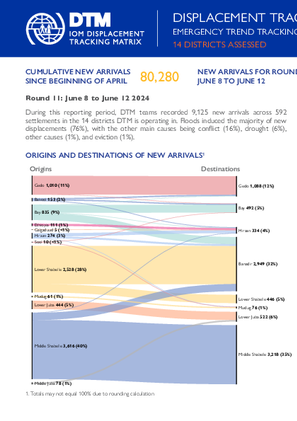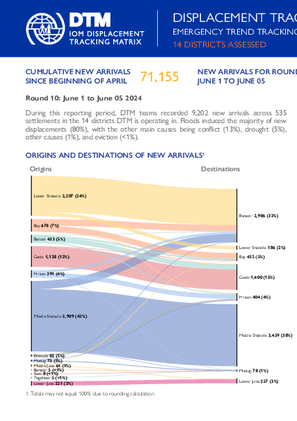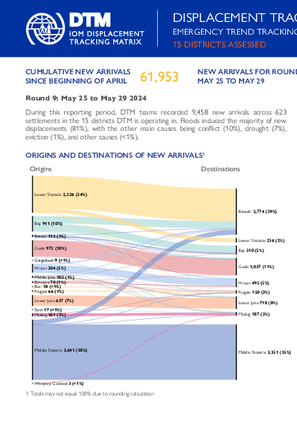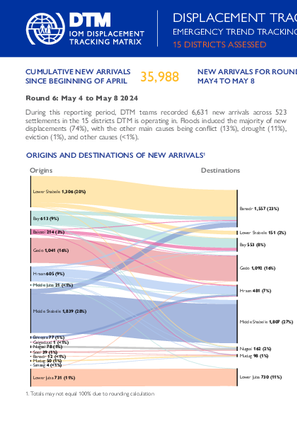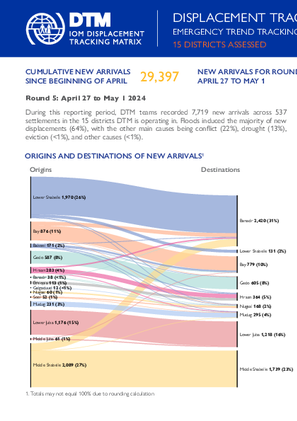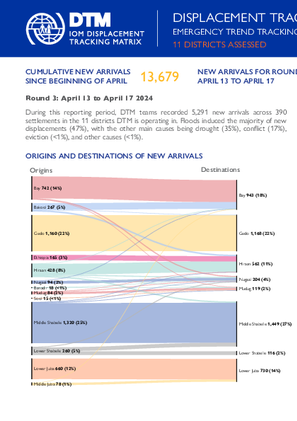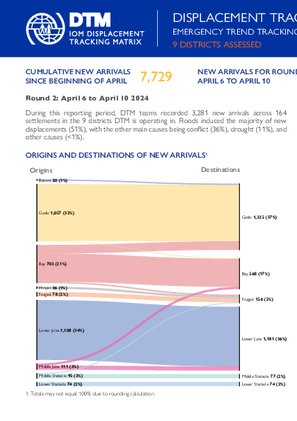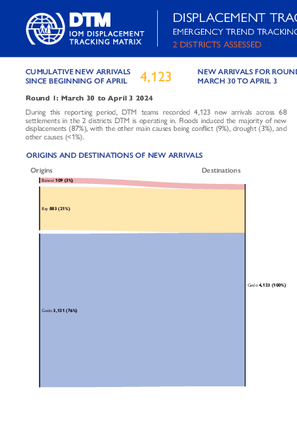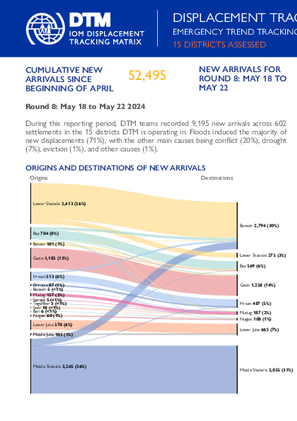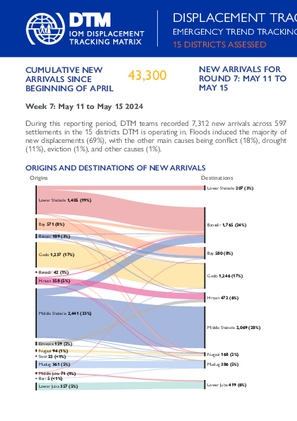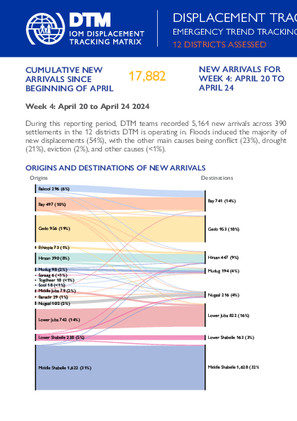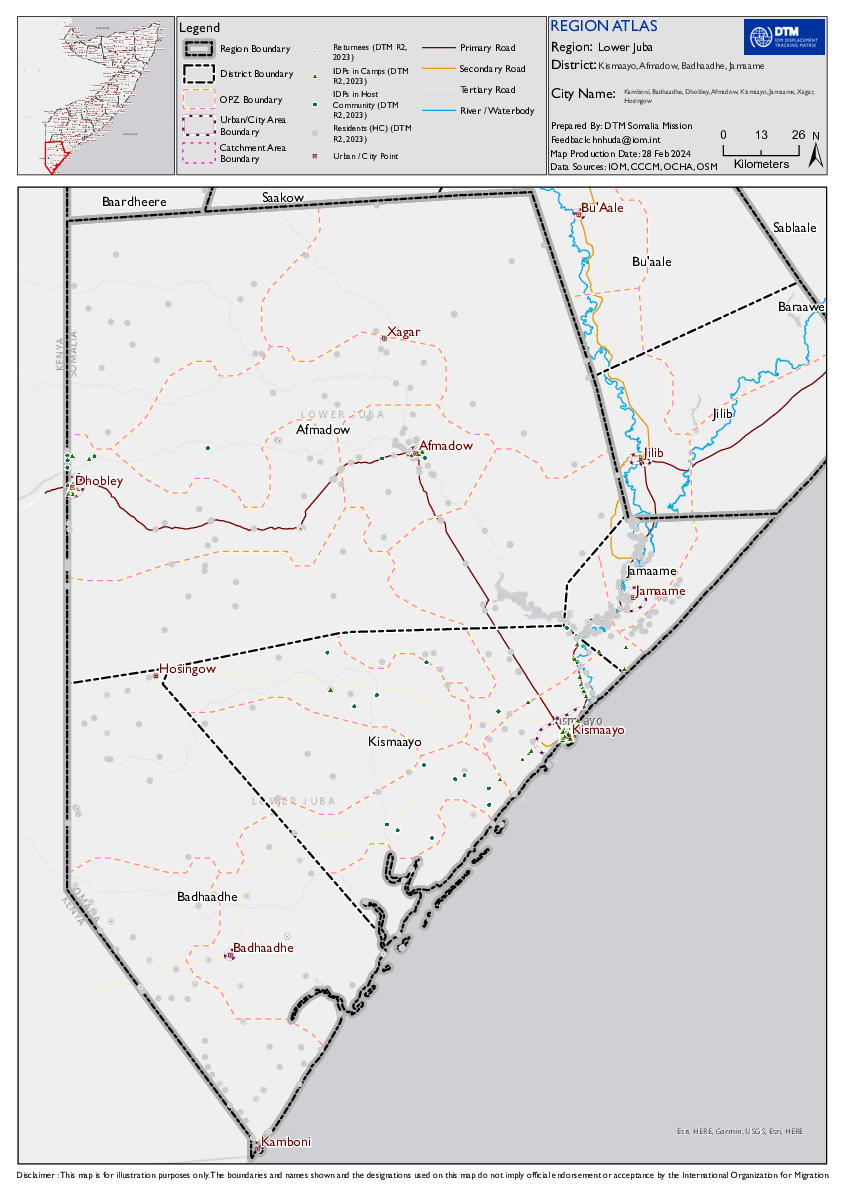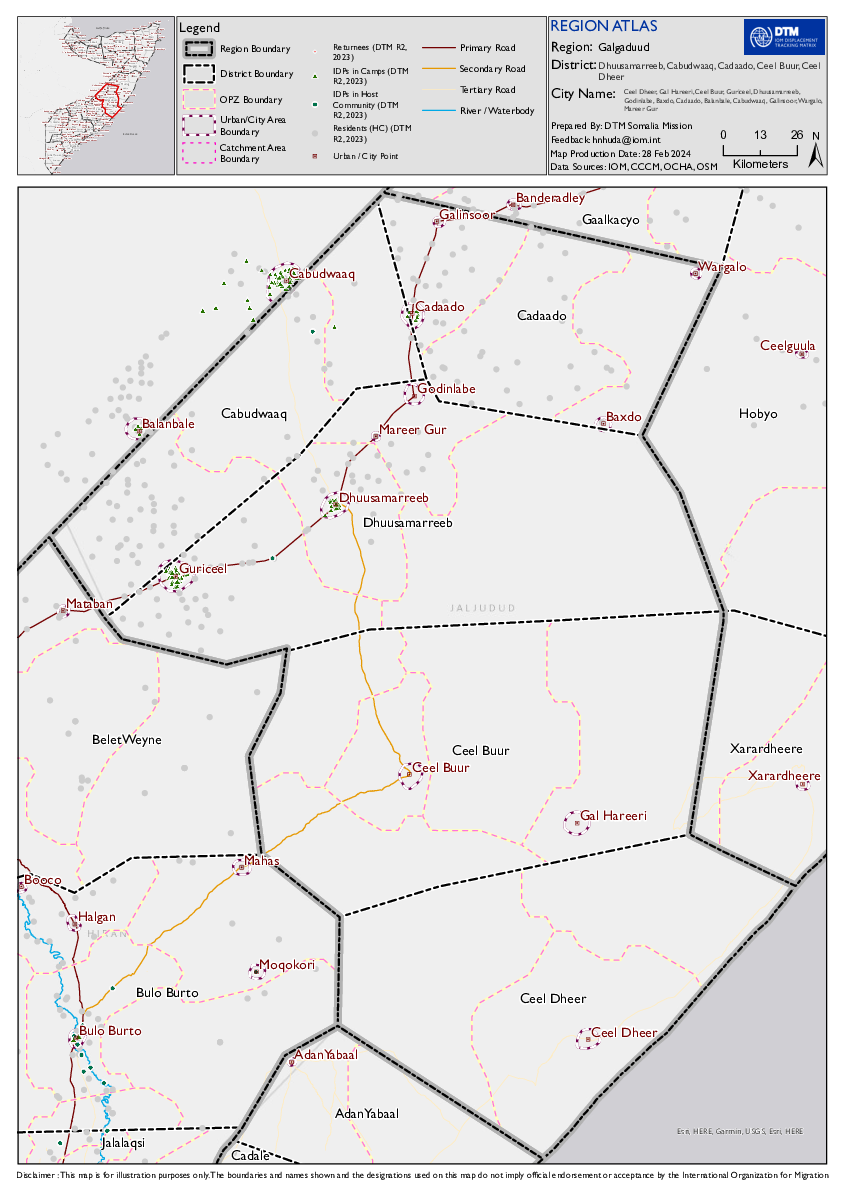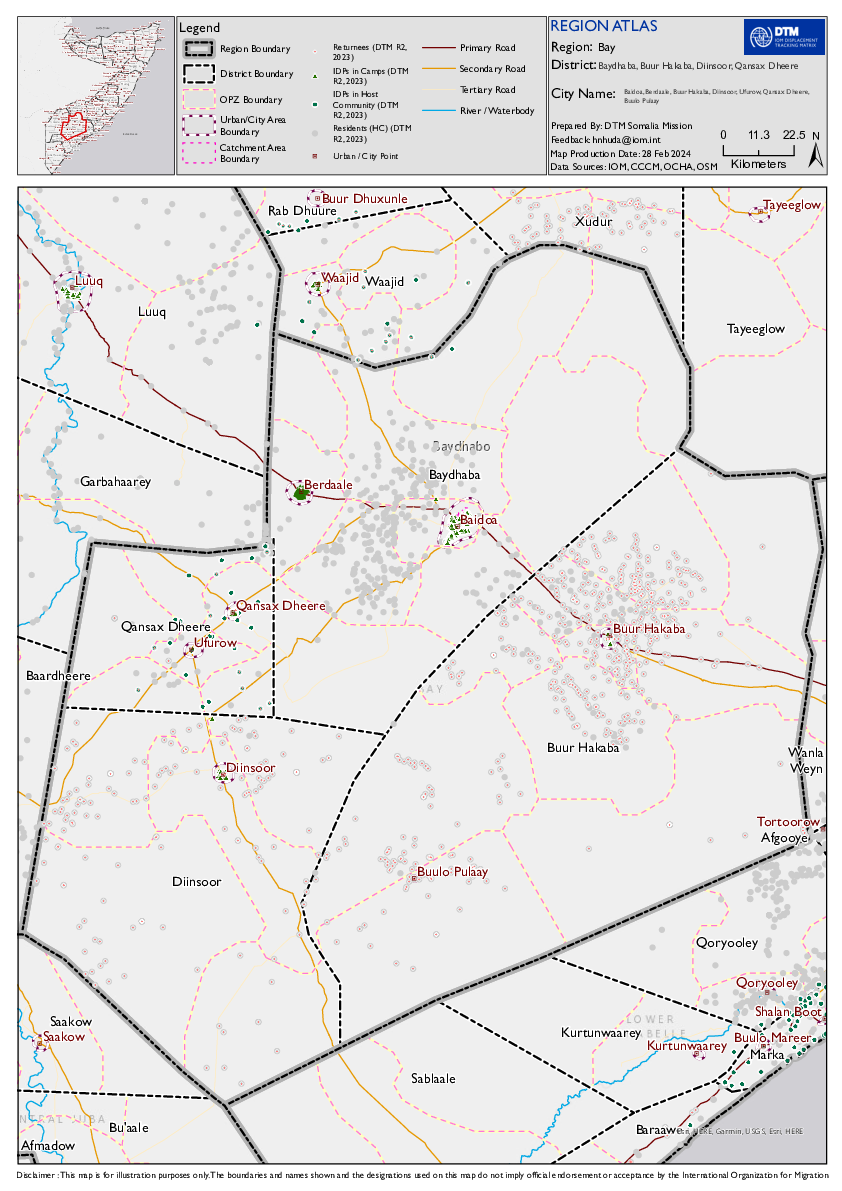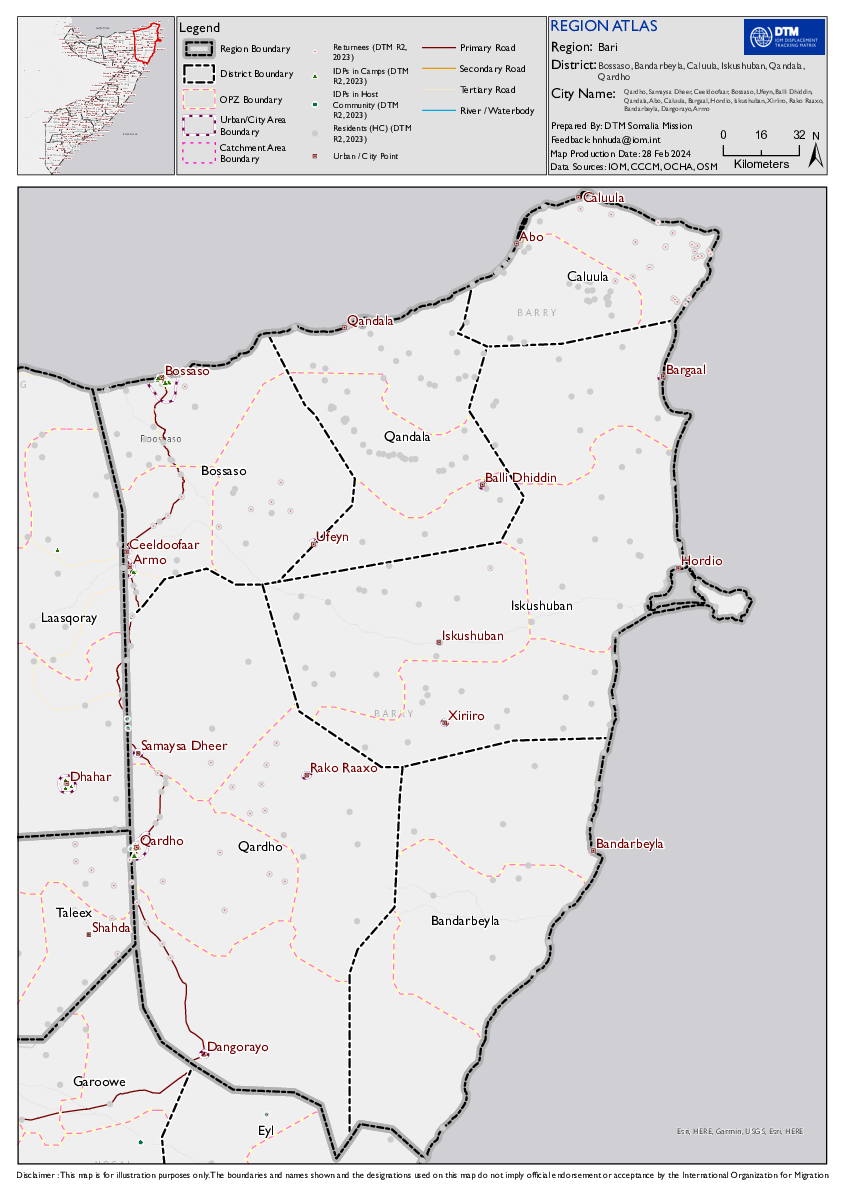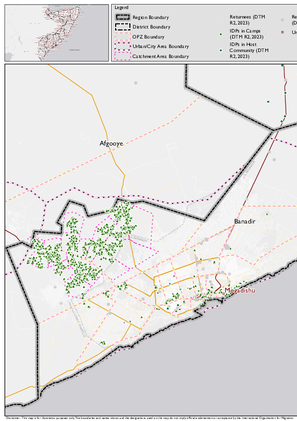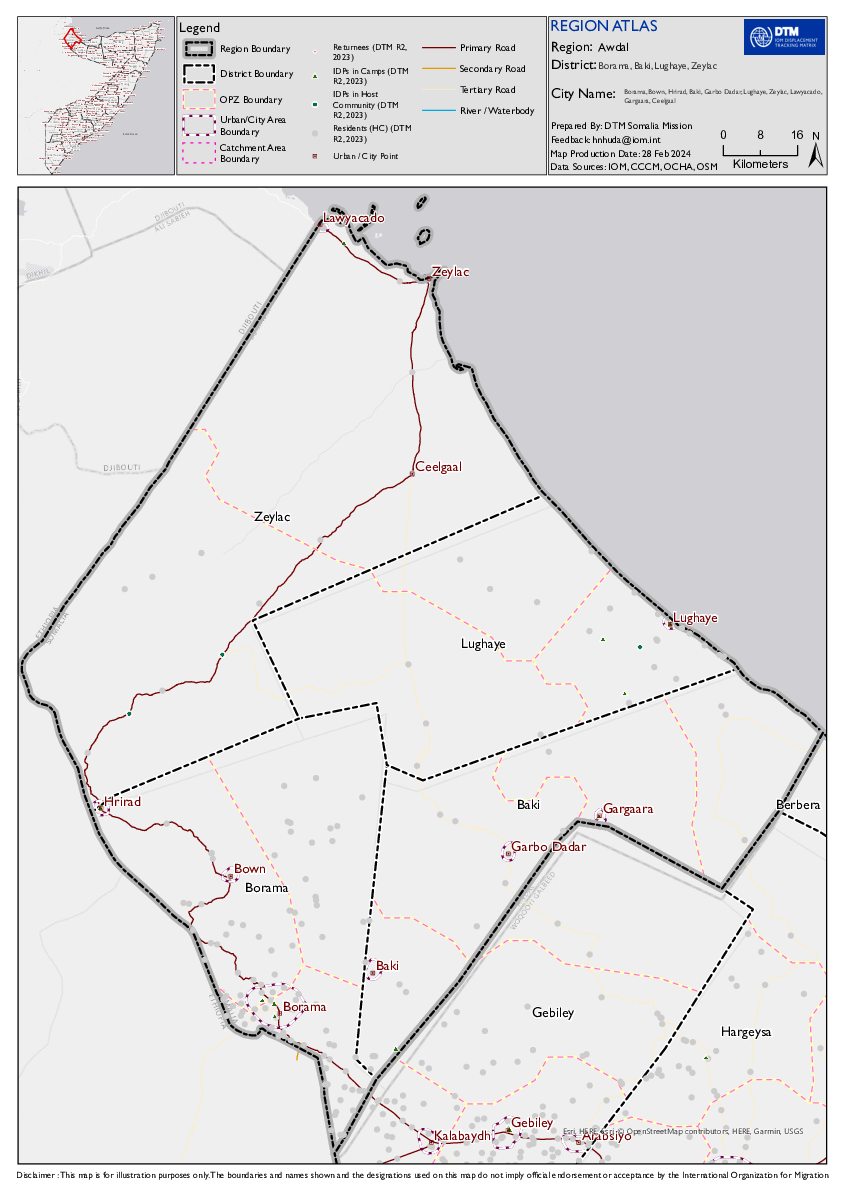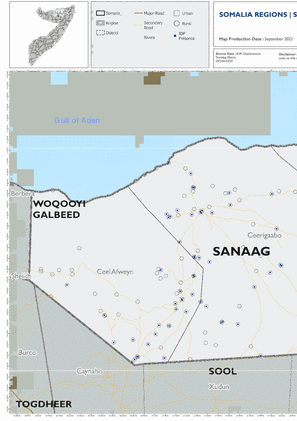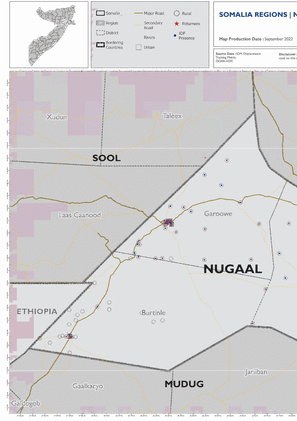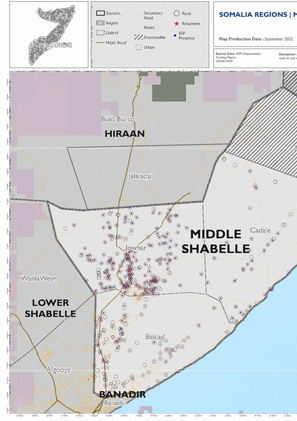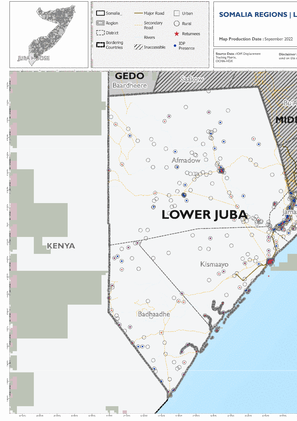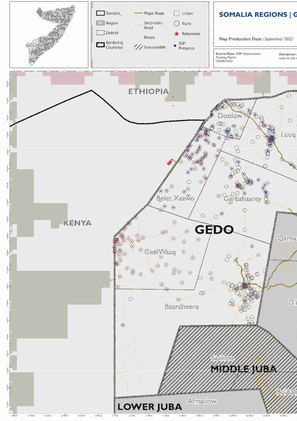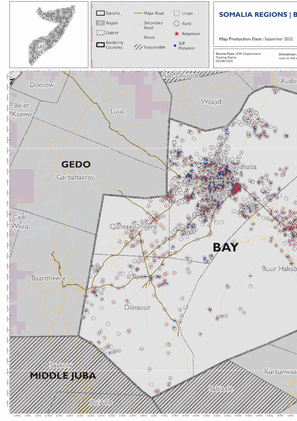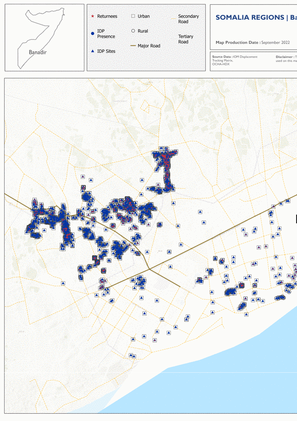-
Countries
-
Data and Analysis
-
Special Focus
-
Crisis Responses
Somalia
Somalia
Suivi des PDI
Mouvements de déplacement
3,862,000
IDMC 2023
cycle de collecte de données
À propos Somalia
IOM Somalia Displacement Tracking Matrix (DTM) aims to collect, analysis and disseminate information on displacement. DTM is IOM’s information management system to track and monitor numbers, locations, movements, needs and vulnerabilities of displaced people. The data outputs, including reports, maps, datasets and online interactive resources, support responses in humanitarian crisis, evidence-based decision making, durable solutions programming and migration research. DTM Somalia was first launch in 2016.
Since the collapse of the Somali central government in 1991, Somalia has suffered a highly complex protracted conflict characterized by changing political dynamics and power shifts. Forced displacement remains an ongoing reality for people living in Somalia due to conflict, environmental hardships, combined with inadequate resource distribution that is often exacerbated by clan-based, ideological differences and land and natural resource competition. Natural hazards, including drought and flooding, combined with widespread security threats have caused one of the world’s largest displacement crises, with 3.8 million IDPs recorded at the end of 2022. Somalia also has a strategic geographical position on the eastern route, which connects the Horn of Africa to the Gulf countries, representing one of the most dangerous and frequented migration corridors in the world.
Bailleurs de fonds
- EU
- ECHO
- BHA
- Canada
- JSB
- World Bank
Somalia — Border Point Flow Monitoring — (May 2024)
A total of 24,430 movements were observed in May 2024, representing 8% increase compared to April 2024 when 22,611 movements were observed during this period.
Somalia — Emergency Trend Tracking Report — Round 15 (July 2024)
This latest round of Emergency Trends Tracking was initiated in April 2024 to monitor displacements movements during the Gu rainy season.
Somalia — Emergency Trend Tracking Report — Round 14 (July 2024)
This latest round of Emergency Trends Tracking was initiated in April 2024 to monitor displacements movements during the Gu rainy season.
Somalia — Border Point Flow Monitoring — (April 2024)
IOM Somalia DTM’s flow monitoring team tracks migrant movements at seven active Flow Monitoring Points (FMPs) along the border with Ethiopia, Kenya, and Djibouti and at Bossa FMP on the coast.
Somalia — Border Point Flow Monitoring — (March 2024)
A total of 26,793 movements were observed in March 2024, representing a 35% increase compared to February 2024 when 19,813 movements were observed during this period.
Somalia — Border Point Flow Monitoring — (February 2024)
A total of 19,813 movements were observed in February 2024, representing a 6% decrease compared to January 2024 when 21,115 movements were observed during this period.
Somalia — Border Point Flow Monitoring — (January 2024)
A total of 21,115 movements were observed in January 2024, representing a 10% increase compared to December 2023 when 19,192 movements were observed during this period.
Somalia — Emergency Trend Tracking Report — Round 13 (June 2024)
During this reporting period, DTM teams recorded 6,070 new arrivals across 511 settlements in the 15 districts DTM is operating in. Floods induced the majority of new displacements (75%), with the other main causes being conflict (15%), drought (7%), other causes (2%), and eviction (1%).
Somalia — Baseline Assessment Summary Report (Hirshabelle, Jubaland, South-West State) — Round 3 (February – March 2024)
Somalia has experienced numerous conflicts, inter-communal violence, and natural disasters since the collapse of the Somali State in 1991. This has led to large recurring waves of forced displacement both within Somalia and into neighbouring countries and beyond.
Somalia — Baseline Assessment Regional Report (Hirshabelle, Jubaland, South-West State) — Round 3 (February – March 2024)
Baseline 2, an area-based assessment, is the second step of Mobility Tracking implemented at settlement level and aims to quantify presence of population categories.
Somalia — Emergency Trend Tracking Report — Round 12 (June 2024)
This latest round of Emergency Trends Tracking was initiated in April 2024 to monitor displacements movements during the Gu rainy season.
Somalia — Disaster Risk Assessment: Assessment of Community Coping Mechanisms in Flood Prone Areas in Somalia
The assessment of community coping mechanisms conducted during the El Niño period of 2023 sought to evaluate the strategies employed by communities impacted by flooding along River Juba and Shabelle.
Somalia — Disaster Risk Assessment: Assessment of Early Warning Systems in Flood Prone Areas in Somalia
The primary objective of this assessment was to evaluate the existence and effectiveness of early warning systems for enhanced disaster risk monitoring and reduction across 6 flood-prone districts in Somalia; Balcad, Baardheere, Beledweyne, Bulo Burto, Doolow and Jowhar.
Somalia — Emergency Trend Tracking Report — Round 11 (June 2024)
This latest round of Emergency Trends Tracking was initiated in April 2024 to monitor displacements movements during the Gu rainy season.
Somalia — Emergency Trend Tracking Report — Round 10 (June 2024)
This latest round of Emergency Trends Tracking was initiated in April 2024 to monitor displacements movements during the Gu rainy season.
Somalia — Emergency Trend Tracking Report — Round 9 (May 2024)
This latest round of Emergency Trends Tracking was initiated in April 2024 to monitor displacements movements during the Gu rainy season.
Somalia — Emergency Trend Tracking Report — Round 6 (May 2024)
This latest round of Emergency Trends Tracking was initiated in April 2024 to monitor displacements movements during the Gu rainy season.
Somalia — Emergency Trend Tracking Report — Round 5 (May 2024)
This latest round of Emergency Trends Tracking was initiated in April 2024 to monitor displacements movements during the Gu rainy season.
Somalia — Emergency Trend Tracking Report — Round 3 (April 2024)
This latest round of Emergency Trends Tracking was initiated in April 2024 to monitor displacements movements during the Gu rainy season. Districts covered in this round include Afgooye, Afmadow, Baardheere, Baidoa, Balcad, Belet Weyne, Gaalkacyo, Garoowe, Jowhar, Kismaayo, and Luuq.
Somalia — Emergency Trend Tracking Report — Round 2 (April 2024)
This latest round of Emergency Trends Tracking was initiated in April 2024 to monitor displacements movements during the Gu rainy season. Districts covered in this round include Afgooye, Afmadow, Baardheere, Baidoa, Balcad, Garoowe, Jamaame, Kismaayo, and Luuq.
Somalia — Emergency Trend Tracking Report — Round 1 (April 2024)
This latest round of Emergency Trends Tracking was initiated in April 2024 to monitor displacements movements during the Gu rainy season. Districts covered in this round include Baardheere and Luuq.
Somalia — Emergency Trend Tracking Report — Round 8 (May 2024)
This latest round of Emergency Trends Tracking was initiated in April 2024 to monitor displacements movements during the Gu rainy season. Districts covered in this round include Afgooye, Afmadow, Baardheere, Baidoa, Balcad, Belet Weyne, Gaalkacyo, Garoowe, Jamaame, Jowhar, Kismaayo, and Luuq.
Somalia — Emergency Trend Tracking Report — Round 7 (May 2024)
This latest round of Emergency Trends Tracking was initiated in April 2024 to monitor displacements movements during the Gu rainy season. Districts covered in this round include Afgooye, Afmadow, Baardheere, Baidoa, Balcad, Belet Weyne, Gaalkacyo, Garoowe, Jamaame, Jowhar, Kismaayo, and Luuq.
Somalia — Emergency Trend Tracking Report — Round 4 (April 2024)
This latest round of Emergency Trends Tracking was initiated in April 2024 to monitor displacements movements during the Gu rainy season. Districts covered in this round include Afgooye, Afmadow, Baardheere, Baidoa, Balcad, Belet Weyne, Gaalkacyo, Garoowe, Jamaame, Jowhar, Kismaayo, and Luuq.
Pagination
Somalia - Baseline Assessment (B2) - Pilot Round 0
2020-05-31
A baseline assessment is a sub-component of mobility tracking. It aims to collect data on IDP, migrant or returnee population presence in a defined administrative area of the country.
Somalia - Flow Monitoring April 2019
2019-04-30
Somalia Flow Monitoring data-set for the month of April 2019
Somalia - Flow Monitoring February 2019
2019-02-28
Somalia Flow Monitoring dataset for the month of February 2019
Somalia - Flow Monitoring January 2019
2019-01-31
Somalia Flow Monitoring dataset for the month of January 2019
Somalia - Flow Monitoring December 2018
2018-12-31
Somalia Flow Monitoring Dataset for the month of December 2018
Somalia - Flow Monitoring November 2018
2018-11-30
Somalia Flow Monitoring dataset for the month of November 2018
Somalia — Baseline Assessment — Round 15
2018-11-30
A baseline assessment is a sub-component of mobility tracking. It aims to collect data on IDP, migrant or returnee population presence in a defined administrative area of the country.
Somalia - Flow Monitoring October 2018
2018-10-31
Somalia Flow Monitoring Dataset for the month of October 2018
Somalia — Baseline Assessment — Round 14
2017-10-31
A baseline assessment is a sub-component of mobility tracking. It aims to collect data on IDP, migrant or returnee population presence in a defined administrative area of the country.
Pagination
Baseline 2 Round 2 – IDP and Returnee Overview in Lower Juba Region
Baseline 2, an area-based assessment, is the second step of Mobility Tracking implemented at settlement level and aims to quantify presence of population categories. For the round 2, data collection occurred between February 2023 and January 2024.
Baseline 2 Round 2 – IDP and Returnee Overview in Hiraan Region
Baseline 2, an area-based assessment, is the second step of Mobility Tracking implemented at settlement level and aims to quantify presence of population categories. For the round 2, data collection occurred between February 2023 and January 2024.
Baseline 2 Round 2 – IDP and Returnee Overview in Gedo Region
Baseline 2, an area-based assessment, is the second step of Mobility Tracking implemented at settlement level and aims to quantify presence of population categories. For the round 2, data collection occurred between February 2023 and January 2024.
Baseline 2 Round 2 – IDP and Returnee Overview in Galgaduud Region
Baseline 2, an area-based assessment, is the second step of Mobility Tracking implemented at settlement level and aims to quantify presence of population categories. For the round 2, data collection occurred between February 2023 and January 2024.
Baseline 2 Round 2 – IDP and Returnee Overview in Bay Region
Baseline 2, an area-based assessment, is the second step of Mobility Tracking implemented at settlement level and aims to quantify presence of population categories. For the round 2, data collection occurred between February 2023 and January 2024.
Baseline 2 Round 2 – IDP and Returnee Overview in Bari Region
Baseline 2, an area-based assessment, is the second step of Mobility Tracking implemented at settlement level and aims to quantify presence of population categories. For the round 2, data collection occurred between February 2023 and January 2024.
Baseline 2 Round 2 – IDP and Returnee Overview in Banadir Region
Baseline 2, an area-based assessment, is the second step of Mobility Tracking implemented at settlement level and aims to quantify presence of population categories. For the round 2, data collection occurred between February 2023 and January 2024.
Baseline 2 Round 2 – IDP and Returnee Overview in Bakool Region
Baseline 2, an area-based assessment, is the second step of Mobility Tracking implemented at settlement level and aims to quantify presence of population categories. For the round 2, data collection occurred between February 2023 and January 2024.
Somalia – Baseline 2 Round 2 – IDP and Returnee Overview in Awdal Region
Baseline 2, an area-based assessment, is the second step of Mobility Tracking implemented at settlement level and aims to quantify presence of population categories. For the round 2, data collection occurred between February 2023 and January 2024.















